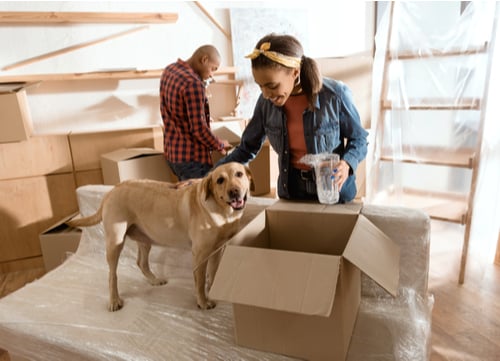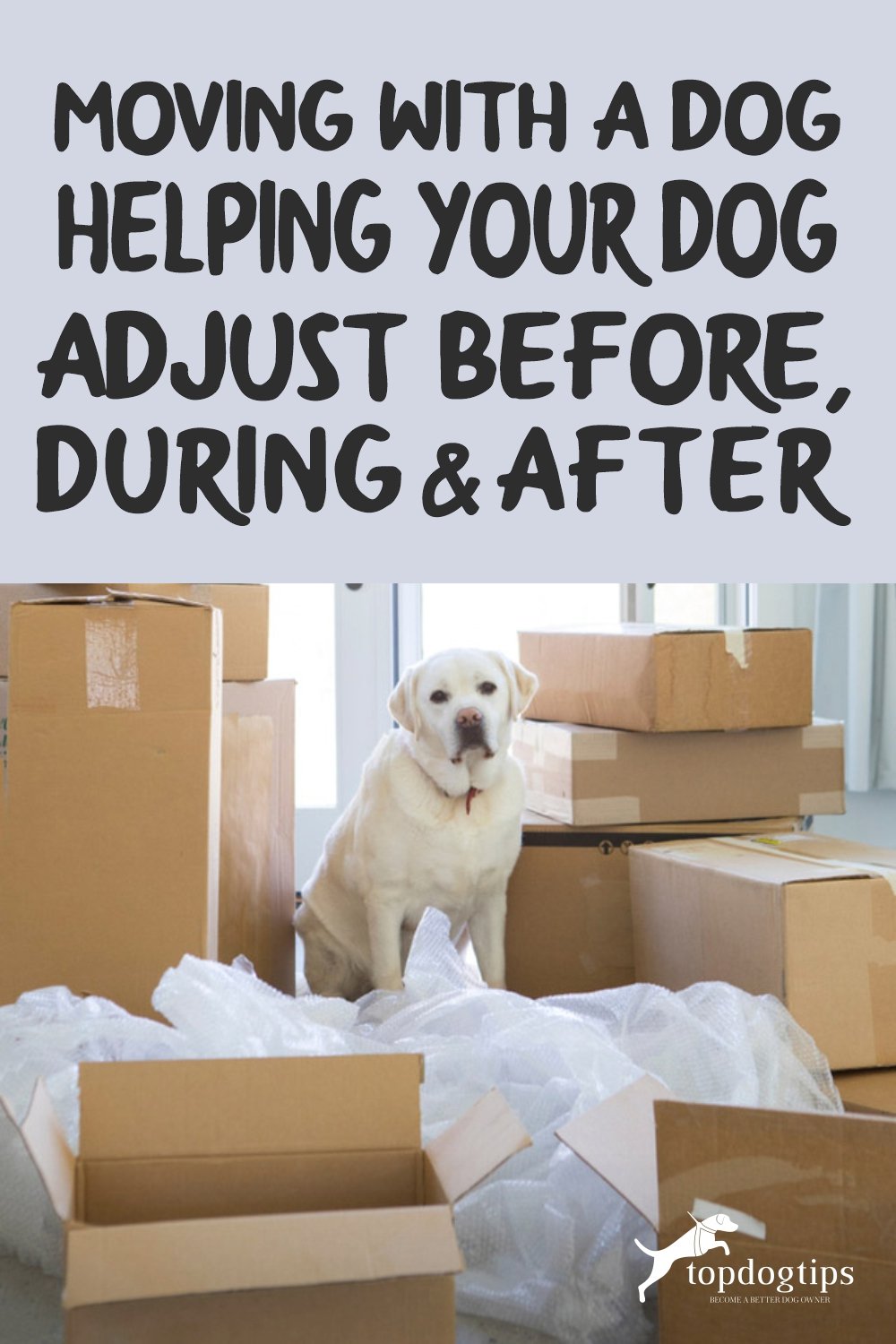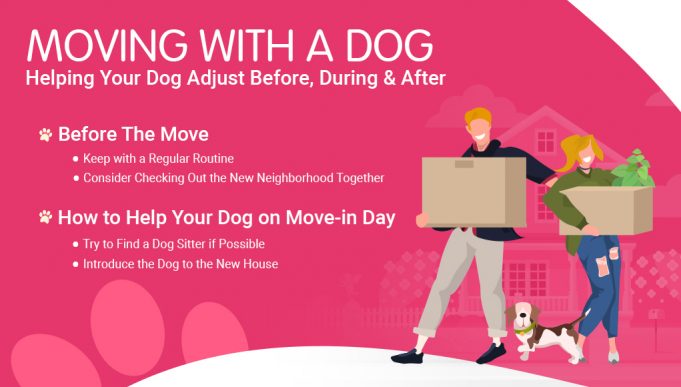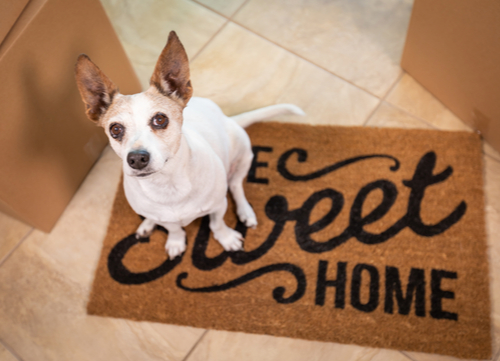Moving can be a fun. It is an exciting time for everyone involved. It is important to remember that our canine companions often fail to share in our excitement. That’s because dogs thrive in environments of stability and calm. Moving disrupts normal routines, sights, sounds, and environments. This is particularly true for families relocating large distances or requiring plane transportation. Before you dive into the chaos often found with moving, consider the following tips to ensure a smooth transition from one home to another when moving with a dog.

Before The Move
You may not see it as a big deal in getting packed. Starting to pull out moving supplies can often trigger anxiety and panic when it comes to your canine. That’s because dogs are creatures of routine, thriving in a constant and consistent environment. If you’ve traveled in the past, there’s a chance your dog is connecting suitcases and carry-on luggage with your departure. That’s why it’s so important to get your dog used to packing supplies like boxes, tissue, and packing tape before you start hauling away anything. For dogs with separation issues, this can make all the difference between a smooth transition and one filled with troubling behavior, when moving with a dog.
Introducing your dog to packing materials starts by bringing in a few supplies and leaving them in an open area. Don’t acknowledge the boxes or tape; the idea is to allow your dog the opportunity to explore without pressure. Watch their body language as they discover the new items to create a positive (or, in the worst case, a neutral experience) in mind. Likewise, you can also similarly desensitize packing tape by throwing a treat toward your dog every time the “funny” sound occurs.
Keep with a Regular Routine
As much as we’d love to hunker down and get a room packed up after work, your dog’s mental health needs to maintain a similar schedule throughout the week. Ensure you stay consistent with regular physical activity (like a normal walk or playtimes) and feeding times. Consistency will help your dog remain relaxed throughout the chaos that happens during a move.
When moving with a dog, their schedules are abruptly changed, it is common for your dog to react with anxiety. Pacing, panting, continuous yawning, and destructive behaviors are all indicators that your pup isn’t dealing well with the changes at hand. While the occasional change is bound to happen, keeping things as normal as possible for his sake is important.
Offer Plenty of Physical Exercise
Getting enough physical activity is important for anyone, but it’s essential for dogs facing big life changes. Make sure your dog is getting plenty of time outside to run and play. This can include a run through the park, playing fetch in the backyard, or a long hike through the trails. Whatever you’re doing, make sure that your dog can enjoy plenty of time burning off excess energy. If you’re looking for different activities for your pup, consider swimming, flyball, or agility. Aim for at least 60 minutes of activity a day.
Engage Your Dog’s Mental Capacity
Mental enrichment is a huge stress reducer for your dog, which can limit destructive behaviors like chewing and digging. Make sure to offer a few different interactive toys for your dog to play with, particularly toys built tough, and offer a challenge to get food/treats out. Using these toys has a duplicate purpose; it can tire out the dog’s brain and reduce stress. When a dog’s mind focuses on one specific activity, it can reduce anxiety overall.
Mental stimulation doesn’t have to focus on food-specific activities either exclusively; they can actually include new scents, scenery, or activities they’ve never tried before. Consider walking around a new path they’ve never explored or perhaps bringing them to the beach to learn how to swim. Getting outside isn’t just beneficial for your dog either; it can help lower your overall stress and well-being. Take the time to get outside and enjoy an activity whenever possible will help when moving with a dog.
Prepare a Safe Space for Your Dog
With the moving day around the corner, having a calm and quiet place for them to stay can make the difference between a successful move or a chaotic experience. Make sure you scope out the room before moving day, ensuring they have a safe place that includes their favorite toys, food and water, and familiar smells. This can be a small bedroom, bathroom, or dog crate, as long as they’re away from the movements and noises that happen with moving. Make sure you also create a sign for the door notifying any friends and family about the dog inside the room (include “do not enter”) to prevent an unsuspecting person from opening the door and startling the pup.
Consider Checking Out the New Neighborhood Together
With all the new sights and smells of the neighborhood, why not bring your pup along for a bit of exploring before moving with a dog? Please spend a few hours with your dog getting to know the trails, pathways, and parks with your canine, allowing them to get used to the smells and sounds the new home will bring. Helping your dog feel acclimated and comfortable in this environment can make transitioning much less stressful overall. Also, look into local dog parks and daycares that your pup can join. This will give him the opportunity (and you) to socialize with new friends and playmates before the big day.
Look into Local Dog Services in the New Area
One of the worst things for your dog is a lapse of their normal routines, including physical well-being like veterinarians, groomers, and other treatments they need to feel their best. Spend some time researching new veterinarian clinics, whether through a search engine, social media, or through a vet network.
Talk to your current veterinarian to have your account switched to the new clinic shortly after your move-in. Schedule a meet and greet with the new vet shortly after moving into your new home. This way, you’ll be familiar with their office, location, and personnel, before an emergency appointment.
Pack an Overnight Bag for Your Dog
When you pack a bag with toothbrushes, changes of clothing, essential items, and personal belongings in preparation for moving day, don't forget about your animals too. Set aside a bag with food, dishes, a leash, blankets, or any needed medications for your pet for moving day. You’ll want to ensure you have at least two days worth of products in case there are any delays with unpacking.
How to Help Your Dog on Move-in Day
Try to Find a Dog Sitter if Possible
Although we all enjoy having our dogs with us on a daily basis, when it comes to moving day, look into finding a reputable sitter, friend, or family member to take care of your pooch. Often many people are coming into and out of the house throughout the day carrying heavy boxes, furniture, and electronics, making your pup susceptible to getting stepped on, or lost in the shuffle. Extra people in the home can also make the day exceptionally difficult from an anxiety standpoint; unfamiliar voices and sounds can stress your dog out—which can be as drastic as acting in aggression. If you can’t find someone to take care of your furry companions, consider setting a specific location for your dog to stay throughout the day. Please make sure the door is marked and everyone is aware that they are in there and shouldn’t be disturbed.
Reduce the Amount of Food Offered
You should never deny your dog a full meal. But it may be a wise idea to reduce the amount of food the night before when moving with a dog. Having a full stomach can increase the chance of gastro problems. The morning of the move can be a high-stress situation. This may cause nausea and vomiting. Once you’ve moved in, feed the dog the lessened amount for another day and then gradually increase the amount. Do this until your back to a normal level.
Bring Their Old Items
Many pet owners love the idea of moving into a new home with fresh and new items, including a pet bed, toys, blanket, or similar. Unfortunately, removing the dog’s old blankets and bedding creates a new environment and smells the pet isn’t used to. Whenever possible, bring any item they currently have (and use) from the old home and show your dog the new location. This also includes pet bowls too as the scents their familiar with can have a calming effect overall.
Introduce the Dog to the New House
Although you’re welcome to simply let your dog roam freely throughout the new home. The space can be overwhelming and even scary for young and old dogs alike. After arriving at the new property, keep your dog on a leash and walk through the house together. If your dog is food motivated, offer a small treat in every room to bring a positive association to the new space. Try to remember that the new property is entirely new and confusing to your dog; patience, love, and calm affirmations can go a long way in setting the best start.
Go for a walk together
We know getting your boxes unpacked and put away is long, tiring, and overwhelming. A dog is quick to pick up on the emotional vibrations you’re feeling, particularly when you’ve become stressed. We suggest when the initial move is finished, take a twenty-minute walk around your new neighborhood. The fresh air will help calm your nerves and stress. It will also give you the opportunity to connect with your dog after a long and busy day.
Check the Property
While we’d like to think that leaving dangerous, poisonous, or problematic items isn’t a concern, occasionally, things get left behind that can harm our furry companions. Always take the time to look throughout the property for anything a dog might want to explore further. Pay attention to sharp objects, unsteady ground, cleaning products, or anything that may pose a choking hazard. Keep your dog on a leash and under direct supervision just to be safe. Do this until the new property has been thoroughly searched.
Moving isn’t always the easiest task to perform. Often it becomes harder when you have a dog to consider among the chaos. Always make sure to leave yourself plenty of time to pack before the move and label everything carefully. Take care when packing anything belonging to your dog. They will likely use those items for comfort prior to the move. Try not to removed their things leading up to the big day. This may cause anxiety and stress to increase dramatically. Remember never pack dog food with anything else within the home. This is particularly true with chemicals or cleaning products.
Older dogs and dogs with separation anxiety may have a harder time adapting than younger dogs. Remain patient and try to give the pooch a proper transition period. Although it can be frustrating, accidents and disruptive behaviors like digging or chewing aren’t uncommon.
Whenever possible, redirect the behaviors. You may find that your dog is soiling inside the home. Consider treating your dog as a puppy and begin potty training all over again. Limit the amount of area your dog has access to within the home until the establish appropriate bathroom locations. Getting back into a similar routine is the easiest way to encourage a healthy adjustment to the new home. Even if you’re not returning to work right away, consider jumping into the work routine (including walks or daycares).
In Conclusion
Always offer lots of praise, love, and attention throughout the first few months at the new home. Positively establish your new routines (for example, praise when your pup uses the bathroom in the backyard at the new house or finds their crate without guidance). A calm approach, positive reinforcement, and love, your pet will quickly adapt to its new environment. Following these steps to avoid anxiety and fear.
Read Next: 12 Best Dog Anxiety Aids for Calming















